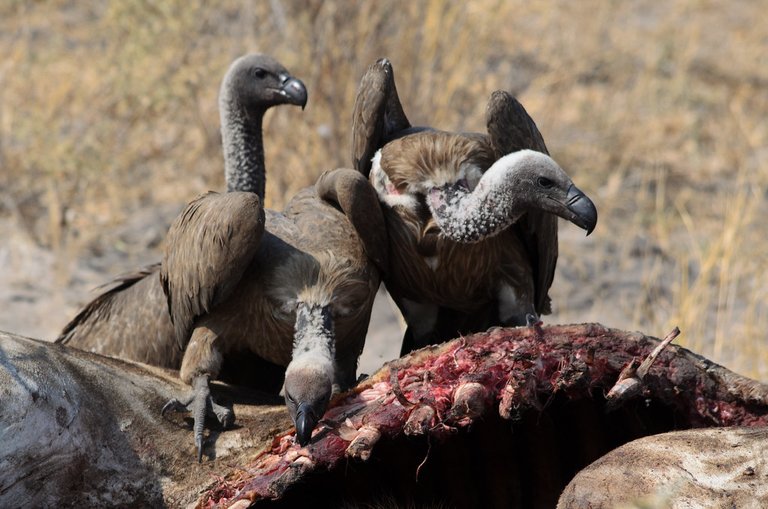Plants, Preys, and Predators Keeping the Circle of Life Continuous
I spend the majority of my television Screen time watching animal documentaries or NAT GEO WILD, and I always enjoy seeing the relationship between Plants, preys, and predators. I take time to see how each specie has to feed on the other just for the circle of life to continue and for them not to go extinct but if we are going to look at the circle of life from another perspective instead of the animal feeding on animals, it could reasonable to the ear, and we could find so many important details that we didn't get when we see them as the 3Ps (Plant, Preys, and Predators).
We will learn to appreciate the circle of life if we are able to see the 3Ps as Elements, Nutrients, and Atoms rather than Plant, Preys, and Predators. I was seeing a documentary where there were lots of dead Wildebeest in a river. They were attacked by crocodile, also some of them drown in the water when trying to cross the river. With this, all the dead bodies of the Wildebeest lay floating on the water and even the crocodile will not be able to eat them all.
While the soft body dissolves and decomposes, the bone which makes up about 50% of the total biomass remains. This can take years to breakdown which means that some essential nutrients are locked inside the bones. These nutrients include Calcium, Potasium, Nitrogen, Phosphorus, and Carbon. These elements are needed by other organisms for their growth but because they are not released, they are unused. The nutrients that dissolves in the water can go to become grass which just becomes food for another wildebeest.
Just like wildebeest are being attacked by crocodiles in water, they are attacked by lions. Actually, I enjoy how Lions go about hunting and killing the beast but then they do not always do a good job when it comes to devouring the meal. They also leave the bones to lay there when they are fill. One time when it is always fun is when the lions are fill and they unknowingly invites the hyenas for a meal either through their noise or from the smell of the carcass. When the Hyenas reach the location, they do a good job in breaking down the bone just as well as they eat the flesh.
Hyenas are able to break into bones, crush them and eat them. While they might sound funny when they make noises, they actually do a good job at cleaning the ecosystem. Asides hyenas, there are other organisms that recycles dead nutrients back to the ecosystem. Other organisms that do this good job are the vulture, the Marabou Stork. Let me quickly explain some thing about vultures. Do you know that a group of vulture flying is known as a kettle, when they land, it is known as a committee, and when they are feasting, it is called a wake.
When vultures fly off and poo, their feces contained nitrogen, iron, and carbon which they ate from the carcass is dropped back into the ecosystem. Another animal you will be surprise to know eat bones once in a while is the giraffe, they do so to get the nutrients (like calcium and phosphorus) they do not get from plants. Either through macro or microorganism, sunlight wearing and tearing or weather weathering, the nutrients in the animal still find its way into the ecosystem. While we might not cherish the relationship and the process, they actually do a lot.
Fungi are organisms that could live on plants and exhibit symbiotic relationship when living in the roots of the plants as they they help the plants fix nutrients and get water and in return get photosynthesis from the plant. We might not appreciate what these microbes do but if we remember that about 78% of the air is nitrogen, and we need microbes to convert this nitrogen to a usable form for plant, then we understand and appreciate their importance.
https://besjournals.onlinelibrary.wiley.com/doi/full/10.1111/j.1365-2435.2006.01225.x
https://www.sfu.ca/biology/faculty/jwmoore/teaching/BIO473/Vanni_2002.pdf
https://news.umich.edu/hyena-scavenging-provides
https://pmc.ncbi.nlm.nih.gov/articles/PMC11112611/
https://4vultures.org/blog/vultures-contribute-to-a-healthier-planet/
https://pmc.ncbi.nlm.nih.gov/articles/PMC5699097/
https://pmc.ncbi.nlm.nih.gov/articles/PMC4778271/


Sending you an Ecency curation vote
Thanks for your contribution to the STEMsocial community. Feel free to join us on discord to get to know the rest of us!
Please consider delegating to the @stemsocial account (85% of the curation rewards are returned).
Thanks for including @stemsocial as a beneficiary, which gives you stronger support.